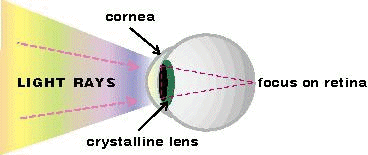IMPERFECT VISION
The eye is a very complex organ with tens of millions of electrical connections and the ability to handle 1.5 million simultaneous messages. It gathers 80% of all the knowledge a human mind can absorb. It is responsible for one of the greatest miracles – sight.

Light enters the eye through the clear outer dome, the cornea, and goes through the pupil. The lens is just through the pupil: it transmits and focuses images on the retina, which is like film in a camera.
The macula is the central receptor site of the retina and provides our sharp vision for tasks such as reading and driving. The retina sends the images via the optic nerve to the brain for visual processing.
Unfortunately, a number of things can go wrong hampering vision and causing distress. If diagnosed in time with early medical intervention, almost all problems can be dealt with successfully, the key being awareness and regular eye exams.
The following are some of the common eyesight problems you may come across in everyday living along with necessary treatment and prevention measures. One or more of the following conditions could be responsible if the images you see are blurred.
Nearsightedness (myopia): Myopia occurs when the eyeball is unusually long causing the light rays to focus in front of the retina. It is usually discovered when children are 8 to 10 years old and progressively worsens during the teenage years as the body is growing rapidly. Between the ages of 20 and 40 there is little change. People who are severely myopic have a higher risk of having a detached retina and need to have their eyes checked regularly. Myopes can have their vision corrected in several ways including: Farsightedness (hypermetropia): Hypermetropia occurs when the eyeball is shorter than normal causing images to be focused behind the retina rather than on it. Contrary to what the word farsightedness suggests, hypermetropic people have blurred vision at all distances unless they make a constant effort to focus. This can lead to strain, headaches, and eye fatigue. In fact, babies and children are usually slightly farsighted; as their eyes grow and lengthen, the condition corrects itself, generally by age seven or eight. However, some young people who remain farsighted are unaware of it, because they have enough flexibility in their focusing power to correct the condition without the aid of glasses or lenses. Astigmatism is corrected by bending the light rays onto a single plane. People who are astigmatic can have their vision corrected by several means, including Presbyopia: In young people, the lens is soft and flexible, and readily changes shape to focus. Over time there is a gradual hardening of the material making up the lens; as a result, its ability to focus decreases steadily. It usually manifests itself around the age of forty. Presbyopic people often believe they have become farsighted; while they can read street signs and watch television comfortably, they are unable to bring small print such as in dictionaries, or close work such as embroidery, into focus. While farsightedness is caused by a misshapen eye, presbyopia is simply the result of the lens becoming less flexible. People who have presbyopia can have their vision corrected by glasses.
We dispense quality lenses for best comfort and vision.